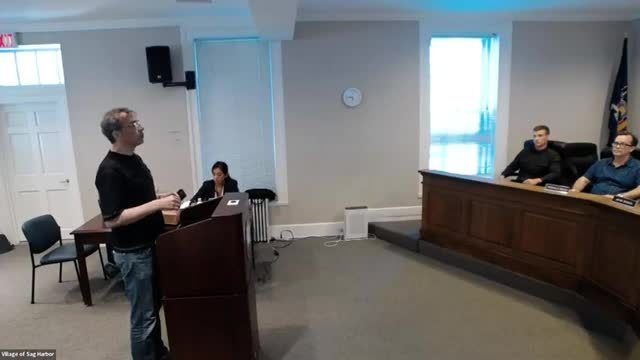Concerns mount over affordable housing project in Sag Harbor
June 14, 2024 | Sag Harbor, Suffolk County, New York

This article was created by AI summarizing key points discussed. AI makes mistakes, so for full details and context, please refer to the video of the full meeting. Please report any errors so we can fix them. Report an error »

In a recent government meeting, community members raised significant concerns regarding a proposed development project in Sag Harbor, which aims to construct a 62,000 square foot building featuring 44 apartments and 8,000 square feet of commercial space. The discussions highlighted critical issues surrounding stormwater management, soil testing, and the project's implications for affordable housing in the area.
One resident emphasized the need for a cistern to manage stormwater, cautioning that simply adding an empty tank could displace existing groundwater, potentially exacerbating flooding issues. They advocated for comprehensive soil testing to determine the depth of sludge in the area, which could complicate construction and remediation efforts.
Concerns about the project's impact on affordable housing were also prominent. The resident argued that the number of apartments proposed may not adequately meet the needs of service staff required for the new commercial spaces, questioning the project's ability to contribute meaningfully to the local affordable housing crisis.
Another speaker raised the potential for unintended consequences, suggesting that the new structure could incentivize neighboring property owners to develop their land, potentially altering the character of Main Street and affecting local vitality.
Planning board member Douglas Newby echoed these concerns, calling for a thorough evaluation of the project's impacts on human health, flooding, traffic, and the overall character of the village. He noted a shift in the project's classification from affordable housing to \"workforce housing,\" a term that lacks clear definition and could further complicate community expectations.
As the meeting concluded, participants expressed a commitment to submitting written comments to ensure that all concerns are formally addressed in the project's Environmental Impact Statement (EIS). The discussions reflect a community deeply engaged in the planning process, seeking to balance development with the preservation of local character and the urgent need for affordable housing solutions.
One resident emphasized the need for a cistern to manage stormwater, cautioning that simply adding an empty tank could displace existing groundwater, potentially exacerbating flooding issues. They advocated for comprehensive soil testing to determine the depth of sludge in the area, which could complicate construction and remediation efforts.
Concerns about the project's impact on affordable housing were also prominent. The resident argued that the number of apartments proposed may not adequately meet the needs of service staff required for the new commercial spaces, questioning the project's ability to contribute meaningfully to the local affordable housing crisis.
Another speaker raised the potential for unintended consequences, suggesting that the new structure could incentivize neighboring property owners to develop their land, potentially altering the character of Main Street and affecting local vitality.
Planning board member Douglas Newby echoed these concerns, calling for a thorough evaluation of the project's impacts on human health, flooding, traffic, and the overall character of the village. He noted a shift in the project's classification from affordable housing to \"workforce housing,\" a term that lacks clear definition and could further complicate community expectations.
As the meeting concluded, participants expressed a commitment to submitting written comments to ensure that all concerns are formally addressed in the project's Environmental Impact Statement (EIS). The discussions reflect a community deeply engaged in the planning process, seeking to balance development with the preservation of local character and the urgent need for affordable housing solutions.
View full meeting
This article is based on a recent meeting—watch the full video and explore the complete transcript for deeper insights into the discussion.
View full meeting
